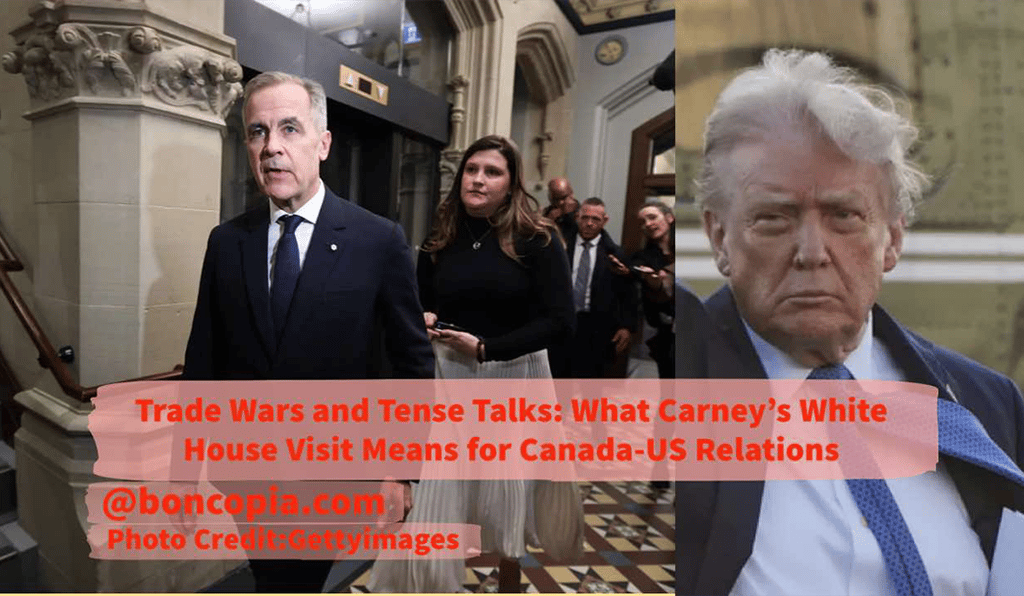Trade Wars and Tense Talks: What Carney’s White House Visit Means for Canada-US Relations
5/5/20253 min read


Trade Wars and Tense Talks: What Carney’s White House Visit Means for Canada-US Relations
Introduction: A High-Stakes Showdown
On Tuesday, Canadian Prime Minister Mark Carney will step into the lion’s den, meeting President Donald Trump at the White House. The visit comes amid escalating tensions, with Trump’s trade war and provocative annexation threats dominating headlines. Carney, fresh off a stunning Liberal Party comeback victory, carries the weight of a nation fed up with Trump’s attacks on Canadian sovereignty. This isn’t just a diplomatic visit—it’s a pivotal moment that could shape Canada-US relations for years. Let’s break down what’s at stake, why it matters, and what to watch for.
The Backdrop: A Trade War and Bold Threats
Trump’s trade policies have hit Canada hard. Tariffs on steel, aluminum, and lumber have strained industries, disrupted supply chains, and driven up costs for consumers on both sides of the border. Canada, heavily reliant on the US as its largest trading partner, has retaliated with targeted tariffs, but the economic toll is mounting. In 2024 alone, bilateral trade losses are estimated at $15 billion, according to the Canadian Chamber of Commerce.
Then there’s the annexation rhetoric. Trump’s offhand remarks about absorbing Canada as a “51st state” have sparked outrage, galvanizing Canadian voters. Carney’s Liberal Party capitalized on this sentiment, framing their election win as a direct rebuke of Trump’s aggression. Polls show 78% of Canadians view Trump’s policies as a threat to national sovereignty, per a recent Angus Reid survey.
Carney’s Challenge: Strength Without Escalation
Carney, a former Bank of Canada governor and global finance heavyweight, is no stranger to high-pressure negotiations. But this meeting is uniquely fraught. “We are meeting as heads of our government,” Carney said Friday. “I am not pretending those discussions will be easy.” His goal? Project strength, defend Canadian interests, and avoid further escalation—all while navigating Trump’s unpredictable style.
Carney’s mandate is clear: protect Canada’s economy and sovereignty. Key issues on the table include:
Trade Tariffs: Can Carney secure exemptions or reductions for Canadian goods?
Energy Exports: With the US reliant on Canadian oil and gas, energy agreements could be a bargaining chip.
Border Security: Trump’s calls for a militarized border threaten cross-border trade and travel.
Carney’s approach will likely blend diplomacy with firm resolve, emphasizing shared economic benefits while drawing red lines on sovereignty. But Trump’s track record suggests he thrives on disruption, making concessions unlikely without significant pressure.
Why This Matters: Beyond the Headlines
The stakes couldn’t be higher. Canada and the US share the world’s longest undefended border and a $1.2 trillion trade relationship. From auto manufacturing to agriculture, millions of jobs depend on stable ties. A prolonged trade war risks recession, with ripple effects across North America. For Canadians, it’s also about identity—resisting external pressures to preserve their way of life.
For the US, the meeting tests Trump’s “America First” doctrine. Alienating Canada could disrupt critical supply chains, especially for energy and critical minerals, where Canada is a top supplier. Yet Trump’s base may cheer his hardline stance, complicating his calculus.
What to Watch For
As Carney and Trump sit down, here are key dynamics to monitor:
Tone and Body Language: Will Trump dominate the conversation, or can Carney hold his ground?
Concrete Outcomes: Will there be progress on tariffs, or just more posturing?
Public Reaction: Canadians are watching closely. A misstep could erode Carney’s post-election momentum.
Social media, especially X, is already buzzing. Posts from Canadian users express cautious optimism about Carney’s resolve, while some US voices double down on Trump’s rhetoric. One X user summed it up: “Carney’s walking into a trap, but he’s got the smarts to flip the script. Let’s see.”
The Bigger Picture: A Test of Leadership
This meeting isn’t just about trade or tariffs—it’s a clash of visions. Carney represents a Canada asserting its independence and multilateral values. Trump embodies a nationalist, zero-sum worldview. The outcome could signal whether cooperation or confrontation will define North America’s future.
For Carney, success means leaving Washington with tangible wins—perhaps a tariff rollback or a commitment to further talks—while reinforcing Canada’s resolve. For Trump, it’s about projecting strength to his base, even if it means doubling down on divisive tactics. Neither can afford to appear weak, but both have incentives to avoid total breakdown.
Conclusion: A Moment That Matters
Tuesday’s meeting is more than a diplomatic photo-op; it’s a defining moment for Canada-US relations. As Mark Carney faces off with Donald Trump, the world will be watching. Can cooler heads prevail, or will the trade war escalate further? Canadians and Americans alike have a stake in the answer.
Thought Questions:
How can Carney balance defending Canada’s interests with avoiding a deeper trade war?
What role should public opinion play in shaping the outcome of these talks?
If you were advising Carney, what one issue would you prioritize in the meeting, and why?
hello@boncopia.com
+13286036419
© 2025. All rights reserved.